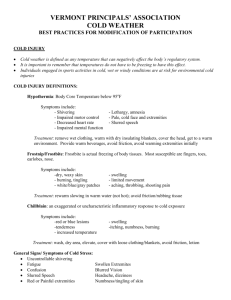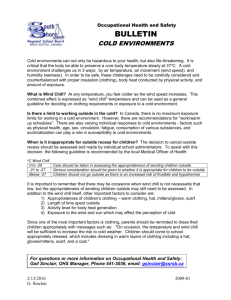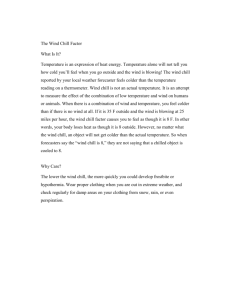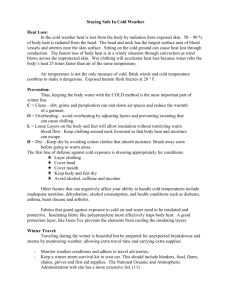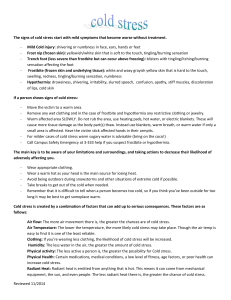Extreme Hot and Cold Weather and UV Protection Guideline
advertisement
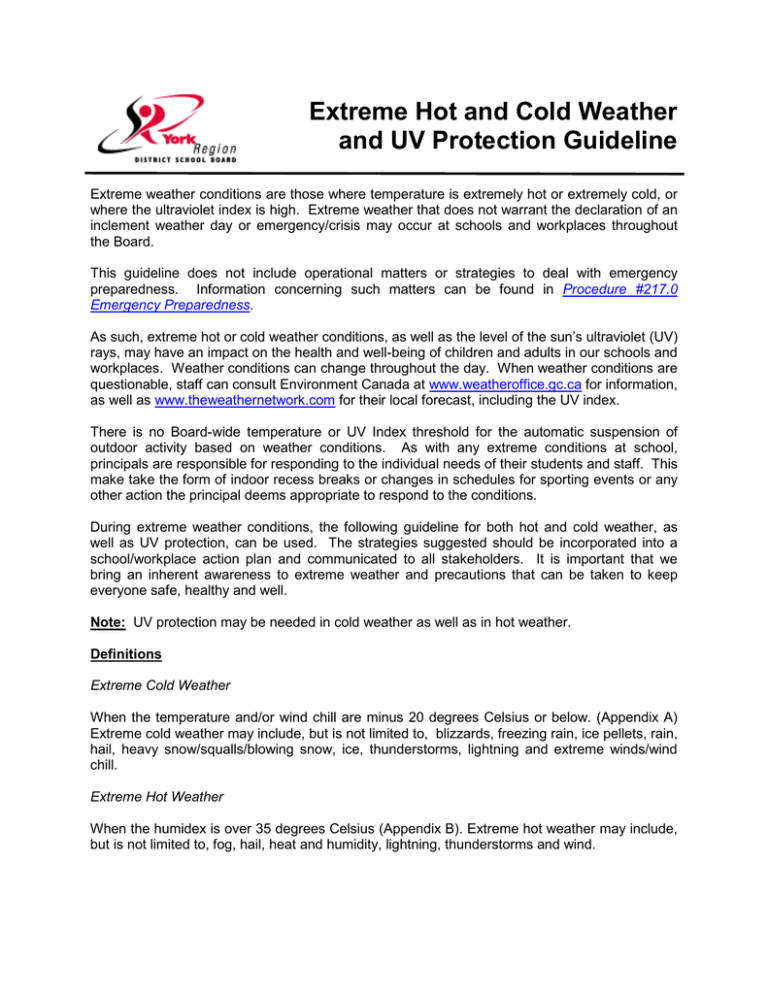
Extreme Hot and Cold Weather and UV Protection Guideline Extreme weather conditions are those where temperature is extremely hot or extremely cold, or where the ultraviolet index is high. Extreme weather that does not warrant the declaration of an inclement weather day or emergency/crisis may occur at schools and workplaces throughout the Board. This guideline does not include operational matters or strategies to deal with emergency preparedness. Information concerning such matters can be found in Procedure #217.0 Emergency Preparedness. As such, extreme hot or cold weather conditions, as well as the level of the sun’s ultraviolet (UV) rays, may have an impact on the health and well-being of children and adults in our schools and workplaces. Weather conditions can change throughout the day. When weather conditions are questionable, staff can consult Environment Canada at www.weatheroffice.gc.ca for information, as well as www.theweathernetwork.com for their local forecast, including the UV index. There is no Board-wide temperature or UV Index threshold for the automatic suspension of outdoor activity based on weather conditions. As with any extreme conditions at school, principals are responsible for responding to the individual needs of their students and staff. This make take the form of indoor recess breaks or changes in schedules for sporting events or any other action the principal deems appropriate to respond to the conditions. During extreme weather conditions, the following guideline for both hot and cold weather, as well as UV protection, can be used. The strategies suggested should be incorporated into a school/workplace action plan and communicated to all stakeholders. It is important that we bring an inherent awareness to extreme weather and precautions that can be taken to keep everyone safe, healthy and well. Note: UV protection may be needed in cold weather as well as in hot weather. Definitions Extreme Cold Weather When the temperature and/or wind chill are minus 20 degrees Celsius or below. (Appendix A) Extreme cold weather may include, but is not limited to, blizzards, freezing rain, ice pellets, rain, hail, heavy snow/squalls/blowing snow, ice, thunderstorms, lightning and extreme winds/wind chill. Extreme Hot Weather When the humidex is over 35 degrees Celsius (Appendix B). Extreme hot weather may include, but is not limited to, fog, hail, heat and humidity, lightning, thunderstorms and wind. Ultraviolet (UV) Rays Most of the UV radiation that reaches the earth’s surface is made up of UVA and UVB rays. The amount of UV radiation one receives depends on the level of the sun’s rays and the amount of time spent in the sun. Although the body can easily detect sunlight and heat, it cannot detect the level of UV radiation. Where the UV index is six (6) or higher, protection is needed. (Appendix C). Extreme Cold Weather Cold temperatures and the presence of ice and snow make winter in Canada a naturally more hazardous season. When severe weather occurs, such as blizzards, freezing rain or extreme wind chill, conditions that are already challenging can become even more dangerous. As with all severe and hazardous weather, knowing what to expect and how to prepare staff and students is essential. How much heat you lose depends not only on the cooling effects of the cold and the wind chill, but on other factors. Your body type helps to determine how quickly you lose heat; people with a tall, slim build become cold much faster than those who are shorter and heavier. Age and physical condition also play a part. Elderly people and children have less muscle mass and as a result, generate less body heat. Sunshine, even on a cold winter day, can also make a difference. Bright sunshine can make you feel as much as ten (10) degrees warmer. Over time, bodies can also adapt to the cold. People who live in a cold climate are often able to withstand cold better than those from warmer climates. Outdoor temperatures and shelter conditions vary substantially from school to school. Winter temperatures in the minus teens and even minus twenties are not uncommon for many Ontario students to face as they travel to and from school. In fact they are quite normal for Northern Ontario students. Health authorities, such as York Region Public Health Services, advise that risks arising from cold weather come from prolonged exposure of unprotected skin. Strategies • Refer to Environment Canada’s Wind Chill Program and Wind Chill Hazards. • Ensure that all staff, students and parents/guardians are made aware whenever the action plan is activated. • Students with health concerns, such as, but not limited to, heavy colds, coughs and flu, which are serious enough to prevent them from participating in physical education, recesses or other outdoor activities, should remain at home until the condition improves. • Students are to come to school ready for winter and prepared to be outdoors after lunch. • When temperatures and/or wind chill reach minus 20 degrees Celcius, consider an indoor routine for recess/events. • When temperatures and/or wind chill reach minus 18-19 degrees Celcius, consider a shortened outdoor routine for recess/events. • Children need to be dressed properly for our invigorating winter days. It is advisable for students to bring extra pants and socks. A change is often necessary due to the wet and cold weather of the winter months. To avoid adding to the clothing collection in the Lost and Found, parents/guardians should be advised to label all articles of clothing, including but not limited to, boots, hats, mitts/gloves, scarves, and snow pants. • Encourage physical activity, such as walking or playing, to increase metabolism – which generates more body heat. • Children should be monitored closely for signs of frostnip, frostbite or difficulty breathing. COLD INJURIES Exposure to the cold can be hazardous or even life-threatening. The body's extremities, such as the ears, nose, fingers and toes, lose heat the fastest. Exposed skin may freeze, causing frostnip or frostbite. In extreme conditions or after prolonged exposure to the cold, the body core can also lose heat, resulting in hypothermia. Hypothermia • • • • Being cold over a prolonged period of time can cause a drop in body temperature (below the normal 37 degrees Celcius). Shivering, confusion and loss of muscular control, such as but not limited to difficulty walking, can occur. May occur from immersion in cold water. It can progress to a life-threatening condition where shivering stops or the person loses consciousness. Cardiac arrest may occur. What to do: • • • • • Get medical attention immediately. Lay the person down and avoid rough handling, particularly if the person is unconscious. Get the person indoors. Gently remove wet clothing. Warm the person gradually and slowly, using available sources of heat. Frostnip • • • A mild form of frostbite, where only the skin freezes. Skin appears yellowish or white, but feels soft to the touch. Painful tingling or burning sensation. What to do: • • • Do not rub or massage the area. Warm the area gradually using use body heat (a warm hand) or warm water. Avoid direct heat which can burn the skin. Once the affected area is warm, do not re-expose it to the cold. Frostbite • • • A more severe condition, where both the skin and the underlying tissue (fat, muscle, bone) are frozen. Skin appears white and waxy and is hard to the touch. No sensation or numbness to the area. What to do: • • • • • Get medical help. Frostbite can be serious, and can result in amputation. Do not rub or massage the area. Do not warm the area until you can ensure it will stay warm. Warm the area gradually; use body heat, or warm water (40°C to 42°C). Avoid direct heat which can burn the skin. Extreme Hot Weather Warm weather brings with it enjoyable activities, but hot weather can also cause stress to our bodies. The Ministry of Labour has developed guidelines to deal with heat stress; however, there is no upper limit for temperature in the work place. The guidelines are intended for use in workplaces where the main contributor to high heat is within the process of the work or where the work is physically demanding. Heat related stress can also be brought on by higher ambient temperatures and humidity levels. Most people feel comfortable in temperature ranges from 18 to 22 degrees Celcius and when relative humidity is about 45 per cent. When ambient temperatures climb over 35 degrees Celcius and high humidity combine to make it feel higher, the body’s ability to cool itself becomes increasingly difficult. Unlike process heat which allows one to become acclimatized, the short duration of hot days does not usually allow this to occur. Some individuals are more susceptible to heat related illness such as children less than 15 years old, seniors 65 years and older, laying sports or engaging in prolonged physical exertion, wearing excessive/heavy clothing and people on certain medications (especially those used to control epilepsy or psychotic disorders). It is very important that each school have an action plan to address student and staff needs during periods of extreme hot weather. Precautions can be taken on very hot days to protect both students and staff from heat related illnesses. Heat stress is affected by four(4) environmental factors; air temperature, humidity, air movement and radiant heat. Individual factors such as age, existing medical and physical conditions also play a part in how an individual copes during times of extremely hot weather. Protection from the harmful effects of UV rays can greatly reduce the lifetime risk of health issues. Hot weather plans should be activated when the following weather/environmental triggers occur: • • • • the humidex reaches or exceeds 35 degrees Celcius; the combination of a smog alert and higher temperatures; during heat waves; or three or more days of temperatures 32 degree Celcius or higher; Strategies • • • • • • • Refer to Environment Canada’s information on humidity and humidex and their strategies for summer comfort. Ensure that all staff, students and parents/guardians are made aware whenever the action plan is activated. If possible reschedule outdoor/indoor physical activities to cooler times of the day or on another day when the humidex is under 35 degrees Celcius. Encourage students and staff to make use of shady areas in the school yard such as under trees, beside the building and under umbrellas. Keep blinds/curtains closed in classrooms directly exposed to sunlight and turn off any unnecessary lights. For hot, humid weather relief in classrooms or portables, Board-approved fans may be used to provide air movement in the room. Some classes may have to be relocated to cooler areas such as gymnasiums or libraries to provide relief. Educate students and parents about the need to wear loose, light clothing that covers their arms and legs, which will help to reduce body heat through moisture evaporation. • Encourage the drinking of water for re-hydration after excessive fluid loss during physical activities or on hot, humid days. Avoid using carbonated drinks with caffeine which promote excessive fluid loss. Drink water before exercise and every 15-20 minutes during exercise. Drink water regularly throughout the day to maintain hydration. HEAT RELATED ILLNESSES The majority of heat related illnesses such as fainting, heat cramps, and heat exhaustion are considered minor. Although not life threatening like heat stroke, they are important to recognize and prevent. Physical activity can be a contributor to heat related illnesses; however it is usually the result of physical activity combined with excessive heat retention and dehydration that causes health issues. The following are some of the signs, symptoms, causes and first-aid treatments for heat related illnesses: Heat Related Fainting Signs and symptoms are dizziness, fatigue, irritability, lack of concentration and loss of the ability to make rational decisions. Caused by the body’s attempt to increase blood flow at skin surfaces in order to reduce body temperatures; resulting in lower blood flow to the brain. First-Aid may include moving to a cooler area, loosening clothes and drinking cool water. Heat Related Cramps Signs and symptoms are painful arm, leg or stomach muscle spasms, thirst, heavy sweating; may occur after prolonged physical exertion. Caused by loss of water and body salts. First-Aid may include drinking water, loosening clothing, resting in a cool location and lightly stretching the affected muscles. Avoid drinking anything with caffeine, such as most cola drinks, tea or coffee Heat Exhaustion Signs and symptoms include those of early heat related fainting plus loss of coordination, collapse, heavy sweating, cool, moist, (clammy), pale skin, dry mouth with excessive thirst, fast pulse, and low to normal temperature. Causes are reduced blood circulation and flow to the brain and dehydration. First-Aid may include slowly giving the person cool water to drink (a half glass of water every 15 minutes is best), have them lie down in a cool area, loosen or remove clothing or hat, splash cool water on body and massage arms and legs. If the person does not show improvement in 10 to 15 minutes, call for emergency medical assistance. Heat Stroke (Call 911 immediately) This is the most severe form of heat related illness and is life threatening. Core body temperature may reach and exceed 40 degrees Celcius. It can even occur in people who are not involved in physical activities or exercise during hot, humid weather. Signs and symptoms are dizziness, confusion, headaches, irrational behaviour, loss of consciousness, reduced or no sweating, fast pulse rate, rapid breathing, convulsions, nausea and vomiting. Causes are dehydration, sustained physical exertion, reduced blood flow to critical parts of the body such as, but not limited to the brain and heart,; body has lost ability to cool itself, and overexposure to high temperatures even without exertion. First-Aid may include moving to acool or shaded area, removing shoes and outer clothing, wrapping in wet cloths, splashing or spraying water onto the skin, fanning rapidly, elevating the legs and clearing vomit to prevent choking. Give water to drink if person is conscious. If the person is not conscious or refuses water, do not force them to drink. Wait for emergency medical help to arrive. It is important to remember that hyperthermia occurs along a continuum starting with heat stress and progressing to heat exhaustion and stroke. If the first signs of heat stress are not dealt with, it can lead to further deterioration and ultimately heat stroke. Heat stroke is a medical emergency with a need to call 911. If there is a person available with first aid training they may respond to the more minor illness; however, anyone can follow the above steps and successfully assist a person suffering from heat related illness. Ultraviolet Rays The UV Index is a measure of the intensity of the sun's ultraviolet radiation in the sunburn spectrum. As the UV Index increases, the sun's rays can do more harm to your skin, eyes and immune system. Paying attention to the UV Index will help students and staff to gauge what precautions are necessary from harmful UV rays. The UV Index in was developed in 1992 as a health protection tool for Canadians to gauge the strength of the ultraviolet radiation they are exposed to. It conforms with the standards set by the World Health Organization (WHO) and is forecast for 48 locations across Canada. The UV Index ranges from 0 to 11+ (the higher the number, the higher the UV levels). The highest values are found on mountain tops at the equator. In Canada, the UV Index generally varies from 0 to 10. The UV Index forecast is the maximum value expected for a given day at solar noon. Generally, the further south in latitude, the higher the UV Index. However the UV Index is also dependent on altitude, reflection, clouds and of course, stratospheric ozone concentrations. Appendix C contains the recommended sun protection actions for each level of the UV Index. Strategies – UV Protection: • Refer to Environment Canada’s information on UV index. • Communicate with students, staff and parents/guardians the need to take precautionary measures to avoid the sun’s rays when the UV Index is high. • When the UV Index is six or over, continue with a regular outdoor routine for recess/events with precautionary measures as cited in Appendix C. • Raise awareness about wearing protective clothing (with UV protection if the index is at 6 or higher), hats (wide brimmed vs. baseball caps), sunglasses and broad spectrum sunscreen with a sun protection factor (SPF) of 30 or higher. UV RELATED INJURIES Sunburns result from too much sun or sun-equivalent exposure. Sunburn is a form of radiation burn that affects living tissue that results from an overexposure to ultraviolet (UV) radiation from the sun. Sunburn Signs and symptoms include, but are not limited to, skin redness and pain, blistering, dehydration, chills, fever, nausea, vomiting and peeling of the skin. Causes include, but are not limited to, unprotected exposure to ultraviolet radiation. First-Aid may include covering the exposed skin, applying sunscreen and staying hydrated. For mild sunburn, applying a cool compress and lotion to the affected skin can reduce the pain associated with sunburn Communication Strategies Effective communication is imperative to ensuring that students, parents and staff are aware of the guidelines to ensure the safety of all during outdoor play. The following are possible strategies to communicate the guidelines: To parents, guardians, caregivers and volunteers: • • • • • during school council meetings; via school newsletters and/or websites; via classroom newsletters and/or websites; during school assemblies and/or community events; and shared by school administration, classroom teachers and other staff as necessary. To staff: • • • • • sharing during leadership, staff and/or division meetings; school SharePoint notices; via staff e-mail distribution list; in-school training for staff on supervision and communicating to students and parents; and add school-specific safety considerations to a teacher’s daybook, etc. to inform occasional teachers. To students: • • • • • • incorporate personal safety and injury prevention as part of the Physical Education Curriculum and reinforce in other appropriate curriculum areas; during morning announcements and reminder announcements later in the day, if warranted; via school, division and/or grade assemblies; communicate in student-friendly language; engaging students by encouraging students to participate in developing sun safety strategies; and Healthy Schools Committees may consider sun safety messaging in their yearly comprehensive health action plan Additional Information: Environment Canada – www.ec.gc.ca/uv Environment Canada Weather Office - http://www.weatheroffice.gc.ca/ Canadian Cancer Society http://www.cancer.ca/Ontario/Prevention/Parents%20for%20Health/Sun%20Safety.aspx?sc_lan g=EN York Region Community and Health Services http://www.york.ca/Services/Public+Health+and+Safety/Cancer+Prevention/Sun+Safety.htm APPENDIX A Wind Chill When the wind makes cold temperatures feel even colder. Environment Canada’s wind chill index will tell you the combined cooling effect of these factors on the human bodyDays with an extreme wind chill value can cause exposed skin to freeze very rapidly, leading to frostbite. Wind chill can also play a major role in hypothermia, because it speeds up the rate at which your body loses heat. Protect yourself by taking appropriate steps to stay warm when you are outdoors. Wind Chill Hazards and What To Do Wind Chill Risk of (degrees Frostbite Celcius) Other Health Concerns What to Do 0 to -9 Low • Slight increase in discomfort • • Dress warmly Stay dry -10 to -27 Low • • Uncomfortable Risk of hypothermia if outside for long periods without adequate protection. • Dress in layers of warm clothing, with an outer layer that is wind-resistant. Wear a hat, mittens or insulated gloves, a scarf and insulated, waterproof footwear. Stay dry. Keep active • • • Risk: exposed skin can freeze in 10 to 30 minutes -28 to -39 • • • Risk of frostnip or frostbite Check face and extremities for numbness or whiteness. Risk of hypothermia if outside for long periods without adequate clothing or shelter from wind and cold. • • • • • -40 to 47 - High risk: exposed skin can freeze in 5 to 10 minutes* • • • High Risk of frostbite Check face and extremities for numbness or whiteness. Risk of hypothermia if outside for long periods without adequate clothing or shelter from wind and cold. • • Dress in layers of warm clothing, with an outer layer that is wind-resistant Cover exposed skin Wear a hat, mittens or insulated gloves, a scarf, neck tube or face mask and insulated, waterproof footwear Stay dry Keep active Dress in layers of warm clothing, with an outer layer that is wind-resistant. Cover all exposed skin. Wind Chill Hazards and What To Do Wind Chill Risk of (degrees Frostbite Celcius) Other Health Concerns What to Do • • • -48 to 54 - Very High risk: exposed skin can freeze in 2 to 5 minutes* • • • Very High Risk of frostbite Check face and extremities frequently for numbness or whiteness. Serious risk of hypothermia if outside for long periods without adequate clothing or shelter from wind and cold. • • • • • • Wear a hat, mittens or insulated gloves, a scarf, neck tube or face mask and insulated, waterproof footwear. Stay dry Keep active. Cover all exposed skin. Dress very warmly in layers of clothing, with an outer layer that is wind-resistant. Wear a hat, mittens or insulated gloves, a scarf, neck tube or face mask and insulated, waterproof footwear. Be ready to cut short or cancel outdoor activities. Stay dry. Keep active. Extremely High • DANGER! Outdoor • Stay indoors. risk: exposed conditions are hazardous. skin can freeze in less than 2 minutes* *In sustained winds over 50 km/h, frostbite can occur faster than indicated. Source: http://www.ec.gc.ca/meteo-weather/default.asp?lang=En&n=46FBA88B-1#Wind Chill -55 and colder APPENDIX B Humidex Table Humidex Degree of Comfort 20 - 29 No discomfort 30 - 39 Some discomfort 40 - 45 Great discomfort; avoid exertion 46 and over Dangerous; possible heat stroke Source: http://www.ec.gc.ca/meteo-weather/default.asp?lang=En&n=86C0425B-1 APPENDIX C Ultraviolet (UV) Index UV Index Description • • 0–2 Low • • 3–5 Moderate 6–7 High • • • 8 – 10 Very High • • • 11+ Extreme • • Sun Protection Actions Minimal sun protection required for normal activity. Wear sunglasses on bright days. If outside for more than one hour, cover up and use sunscreen. Reflection off snow can nearly double UV strength. Wear sunglasses and apply sunscreen. Take precautions - cover up, wear a hat, sunglasses, and sunscreen - especially if you will be outside for 30 minutes or more. Look for shade near midday when the sun is strongest. UV damages the skin and can cause sunburn. Reduce time in the sun between 11 a.m. and 4 p.m. and take full precautions - seek shade, cover up, wear a hat, sunglasses, and sunscreen. Unprotected skin will be damaged and can burn quickly. Avoid the sun between 11 a.m. and 4 p.m. and take full precautions - seek shade, cover up, wear a hat, sunglasses, and sunscreen. Values of 11 or more are very rare in Canada. However, the UV Index can reach 14 or more in the tropics and southern states of the U.S. Take full precautions. Unprotected skin will be damaged and can burn in minutes. Avoid the sun between 11 a.m. and 4 p.m., cover up, wear a hat, sunglasses, and sunscreen White sand and other bright surfaces reflect UV and increase UV exposure Source: Adapted from Environment Canada’s UV Index: http://www.ec.gc.ca/Publications/9C0A3543-2DB7-4673-905D-0541E9622C68/UVIndex.pdf
